Accelerate > Publications
Search this online library featuring the latest FAO publications, issue papers and briefs which offer up-to-date knowledge and innovative insights for SDG acceleration.

Hunger Hotspots: FAO-WFP early warnings on acute food insecurity, November 2023 to April 2024 outlook
2023
The Hunger Hotspots report by WFP and FAO identifies 18 hunger “hotspots” in a total of 22 countries where food security is expected to significantly deteriorate, and the outlook for the next six months from November 2023 to April 2024.
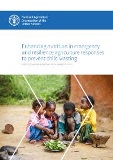
Enhancing nutrition in emergency and resilience agriculture responses to prevent child wasting - FAO's child wasting prevention action plan (2023–2024)
2023
As part of the United Nations Global Action Plan on Child Wasting, FAO requires USD 500 million to implement its action plan to prevent child wasting (2023–2024) in the 15 most-affected countries. FAO aims to reach 1 million vulnerable households with at-risk children, pregnant and lactating women and girls to prevent child wasting or to ensure that there are no relapses for children discharged after undergoing treatment.
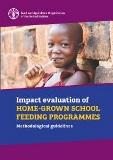
Impact evaluation of home-grown school feeding programmes: Methodological guidelines
2022
This publication seeks to support practitioners by providing methodological guidelines for conducting rigorous impact assessments of Home Grown School Feeding (HGSF) programmes. It presents an overview of the main technical issues to be addressed depending on the characteristics of the context and of the intervention itself.
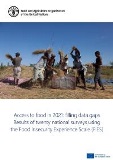
Access to food in 2021: filling data gaps - Results of twenty national surveys using the Food Insecurity Experience Scale (FIES)
2022
This report presents the results of assessments based on the food insecurity experience scale (FIES), data collected by FAO in twenty least developed countries (LDCs), landlocked developing countries (LLDCs) and Small Island Developing States (SIDS) between November 2021 and February 2022. For nine of the countries (including eight SIDS), it was the first time FIES data had been collected.
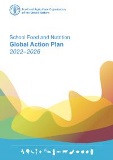
School Food and Nutrition – Global Action Plan 2022–2026
2022
The School food and nutrition - Global action plan seeks to consolidate and guide FAO’s synergistic efforts, setting out priority and concrete outputs to be achieved by 2026.
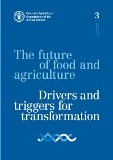
The future of food and agriculture – Drivers and triggers for transformation
2022
This report aims at inspiring strategic thinking and actions to transform agrifood systems towards a sustainable, resilient and inclusive future, by building on both previous reports in the same series as well as on a comprehensive corporate strategic foresight exercise that also nurtured FAO Strategic Framework 2022–31. It analyses major drivers of agrifood systems and explores how their trends could determine alternative futures of agrifood, socioeconomic and environmental systems.

The State of Food Security and Nutrition in the World 2022 - Repurposing food and agricultural policies to make healthy diets more affordable
2022
This year’s report should dispel any lingering doubts that the world is moving backwards in its efforts to end hunger, food insecurity and malnutrition in all its forms. We are now only eight years away from 2030, but the distance to reach many of the SDG 2 targets is growing wider each year. There are indeed efforts to make progress towards SDG 2, yet they are proving insufficient in the face of a more challenging and uncertain context.
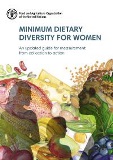
Minimum dietary diversity for women. An updated guide to measurement - from collection to action
2021
This publication is an update to the 2016 FAO/FHI 360 joint publication MDD-W: A Guide to Measurement. It includes guidance on the most accurate and valid methodologies on collecting, analyzing, interpreting, and presenting data on women’s dietary diversity, for use in research, impact assessment and large-scale, health and nutrition surveys such as the Demographic Health Survey (DHS), to generate nationally representative data, that are comparable over time and across countries.
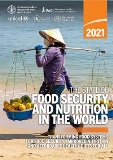
The State of Food Security and Nutrition in the World 2021 - Transforming food systems for food security, improved nutrition and affordable healthy diets for all
2021
In recent years, several major drivers have put the world off track to ending world hunger and malnutrition in all its forms by 2030. The challenges have grown with the COVID-19 pandemic and related containment measures. This report presents the first global assessment of food insecurity and malnutrition for 2020 and offers some indication of what hunger might look like by 2030 in a scenario further complicated by the enduring effects of the COVID-19 pandemic.
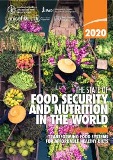
The State of Food Security and Nutrition in the World 2020 - Transforming food systems for affordable healthy diets
2020
Updates for many countries have made it possible to estimate hunger in the world with greater accuracy this year. In particular, newly accessible data enabled the revision of the entire series of undernourishment estimates for China back to 2000, resulting in a substantial downward shift of the series of the number of undernourished in the world.
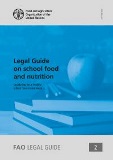
Legal guide on school food and nutrition - Legislating for a healthy school food environment
2020
This Guide promotes a holistic and human rights-based approach to school food and nutrition, in which legislation is an indispensable tool to ensure the sustainability of public policy goals set by a country. In light of international law and standards, it provides practical information and guidance to develop or strengthen national legislation to improve food security and nutrition in schools as well as community development.

School-based food and nutrition education - A white paper on the current state, principles, challenges and recommendations for low- and middle-income countries
2020
School-based food and nutrition education (SFNE) helps schoolchildren and the school community to achieve lasting improvements in their food practices and outlooks; build the capacity to change and to adapt to external change; and pass on their learning to others. SFNE has also an important role in complementing efforts that are being made globally to improve food environments, and in empowering children and adolescents to become active participants in shaping the food system to be better...
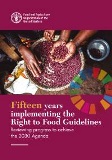
Fifteen years implementing the Right to Food Guidelines - Reviewing progress to achieve the 2030 Agenda
2019
The Right to Food Guidelines provide practical guidance on ways to implement the right to adequate food in a wide range of policy and programmes areas through a human rights-based approach. Since the adoption of the Right to Food Guidelines, FAO and its partners have produced a wealth of tools, strengthened capacity, and facilitated multi-stakeholder dialogues worldwide.
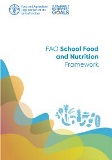
FAO School Food and Nutrition Framework
2019
The FAO School Food and Nutrition Framework aims to support governments and institutions in developing, transforming or strengthening their school policies, programmes and other initiatives for an enhanced and synergistic impact on diets, child and adolescent nutrition, community socioeconomic development and local food systems.

Stepping up school-based food and nutrition education
2019
School-based food and nutrition education (SFNE) represents a crucial opportunity to reach children, families and the broader school community to foster lasting healthy food practices and capacities. The consultation on “Stepping up School-based Food and Nutrition Education: Exploring Challenges, Finding Solutions and Building Partnerships,” was the first of its kind. This report provides a description of the consultation, the results achieved and the recommendations agreed on by the experts.

The State of Food Security and Nutrition in the World 2019 - Safeguarding against economic slowdowns and downturns
2019
This year’s report presents evidence that the absolute number of people who suffer from hunger continues to slowly increase. The report also highlights that food insecurity is more than just hunger. For the first time, the report provides evidence that many people in the world, even if not hungry, experience moderate food insecurity as they face uncertainties about their ability to obtain food and are forced to compromise on the quality and/or quantity of the food they consume.
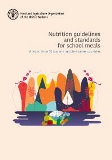
Nutrition guidelines and standards for school meals - A report from 33 low and middle-income countries
2019
Setting nutrition guidelines and standards has been recommended internationally to ensure that school meals are in line with children’s nutrition needs and adequate to their context. This report provides a descriptive overview of the situation of school meal nutrition guidelines and standards in 33 low and middle-income countries as reported through a global survey.
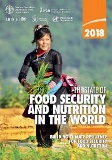
The State of Food Security and Nutrition in the World 2018 - Building climate resilience for food security and nutrition
2018
New evidence this year corroborates the rise in world hunger observed in this report last year, sending a warning that more action is needed if we aspire to end world hunger and malnutrition in all its forms by 2030. Updated estimates show the number of people who suffer from hunger has been growing over the past three years, returning to prevailing levels from almost a decade ago..
Browse by SDG
- SDG1: No Poverty
- SDG2: Zero Hunger
- SDG3: Good Health & Well-being
- SDG4: Quality Education
- SDG5: Gender Equality
- SDG6: Clean Water & Sanitation
- SDG7: Affordable and Clean Energy
- SDG8: Decent Work and Economic Growth
- SDG9: Industry, Innovation and Infrastructure
- SDG10: Reduced Inequalities
- SDG11: Sustainable Cities and Communities
- SDG12: Responsible Consumption and Production
- SDG13: Climate Action
- SDG14: Life Below Water
- SDG15: Life on Land
- SDG16: Peace, Justice and Strong Institutions
- SDG17: Partnerships for the Goals
Browse by Better
Browse by Priority Area
- Innovation for Sustainable Agriculture Production
- Blue Transformation
- One Health
- Small-Scale Producers' Equitable Access to Resources
- Digital Agriculture
- Healthy Diets for All
- Nutrition for the Most Vulnerable
- Safe Food for Everyone
- Reducing Food Loss and Waste
- Transparent Markets and Trade
- Climate Change Mitigating and Adapted Agrifood Systems
- Bioeconomy for Sustainable Food and Agriculture
- Biodiversity and Ecosystem Services for Food and Agriculture
- Achieving Sustainable Urban Food Systems
- Gender Equality and Rural Women's Empowerment
- Inclusive Rural Transformation
- Agriculture and Food Emergencies
- Resilient Agrifood Systems
- Hand-in-Hand Initiative
- Scaling up Investment
